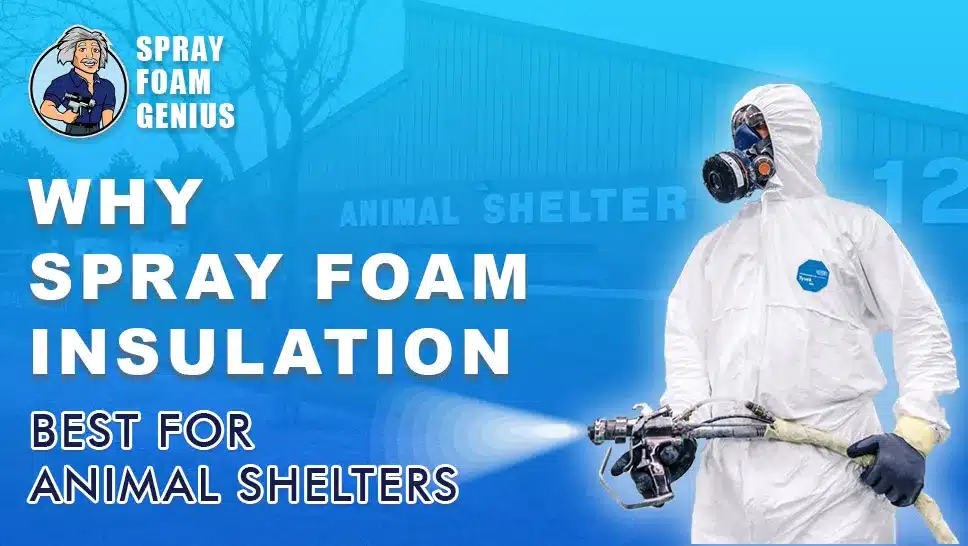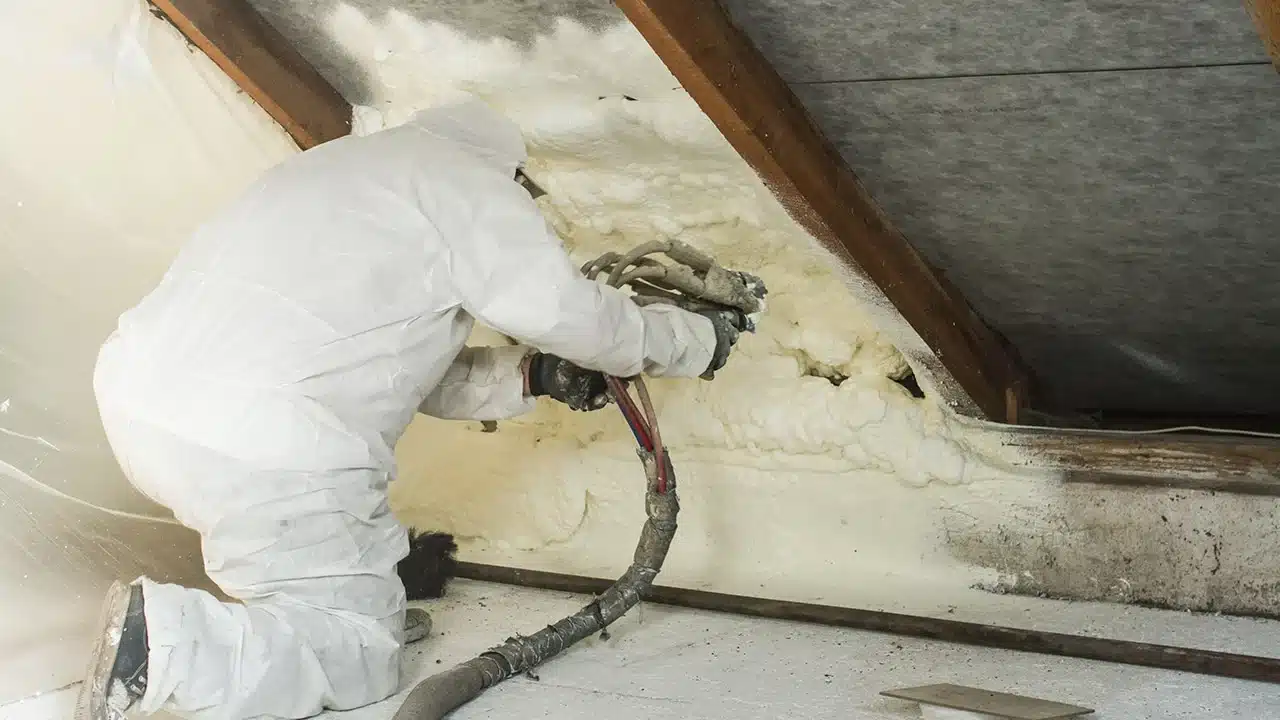
Ensuring the optimal comfort and safety of animals in shelters is paramount. For shelters across the USA and Canada, choosing the right insulation can make a significant difference in creating a conducive environment. Spray foam insulation has emerged as the top choice for animal shelters due to its outstanding performance in thermal control, moisture management, and overall durability. In this detailed guide, we will explore why spray foam insulation stands out as the ideal option for animal shelters, focusing on its numerous benefits, the installation process, cost considerations, and its positive impact on the environment.
Understanding Spray Foam Insulation
Spray foam insulation is a revolutionary material that is applied as a liquid and expands into a foam, creating a seamless and effective barrier against heat, air, and moisture. It consists of two main types: open-cell and closed-cell foam.
Open-Cell vs. Closed-Cell Foam
- Open-Cell Foam: This type of spray foam is softer and more flexible. It has a lower R-value compared to closed-cell foam but is effective for providing good thermal insulation and soundproofing. Open-cell foam is often used in interior applications where flexibility and sound absorption are desired.
- Closed-Cell Foam: This foam is denser and more rigid, offering a higher R-value per inch of thickness. It provides superior insulation and acts as a moisture barrier, making it particularly effective in areas exposed to higher levels of humidity. Closed-cell foam is highly recommended for exterior applications and areas prone to moisture.
How Spray Foam Insulation Works
Spray foam insulation starts as a liquid mixture of isocyanate and polyol resin. When these chemicals are combined and sprayed onto surfaces, they react and expand into a foam. This foam then adheres to surfaces and fills all gaps and voids, creating an airtight and moisture-resistant barrier. This process is highly effective in maintaining consistent temperatures and controlling air and moisture flow.
Benefits of Spray Foam Insulation for Animal Shelters
Superior Thermal Insulation
One of the primary advantages of spray foam insulation is its exceptional thermal insulation properties. The R-value of spray foam insulation, particularly closed-cell foam, is among the highest available. This means it offers excellent resistance to heat flow, which is crucial for maintaining a stable internal temperature in an animal shelter. This stability ensures that animals are kept comfortable regardless of external weather conditions.
Moisture Control
Animal shelters often face challenges with high humidity levels due to the presence of water bowls, frequent cleaning, and the animals themselves. Closed-cell spray foam insulation acts as a robust moisture barrier, preventing water vapor from penetrating walls and causing issues like mold and mildew. By keeping moisture at bay, spray foam insulation helps maintain a healthier environment for both animals and staff.
Effective Air Sealing
Spray foam insulation provides an effective air seal, reducing drafts and preventing outside air from entering the shelter. This capability is crucial for maintaining a stable internal environment, minimizing the workload on heating and cooling systems, and ensuring that the animals remain comfortable. An airtight seal also contributes to energy efficiency by reducing heat loss and gain.
Noise Reduction
Animal shelters are often bustling with various noises from barking, meowing, and general shelter activities. Spray foam insulation contributes to noise reduction by creating a sound barrier. This can lead to a quieter environment, reducing stress and anxiety for the animals and contributing to their overall well-being.
Durability and Longevity
Spray foam insulation is known for its durability and long lifespan. Once applied, it does not settle or degrade over time, maintaining its insulating properties for many years. This longevity means that investing in spray foam insulation is a long-term solution, reducing the need for frequent replacements or repairs and providing ongoing benefits.
Installation Process
Professional Application
The installation of spray foam insulation should be carried out by professionals with expertise in handling and applying this material. The application involves spraying the foam onto surfaces, where it expands and cures. Proper application is essential to ensure that the foam adheres correctly and provides optimal insulation performance.
Site Preparation
Before applying spray foam insulation, the area must be prepared. This includes cleaning surfaces to remove any debris or contaminants and ensuring that they are dry. Any existing insulation or old materials should be removed to allow the spray foam to adhere effectively. Proper site preparation ensures that the insulation performs as intended.
Post-Installation
After the spray foam insulation is applied, it needs time to cure. Curing typically takes a few hours to a day, depending on the type of foam and environmental conditions. Once cured, the foam can be trimmed and finished to create a smooth surface. It is important to follow proper post-installation procedures to ensure the best results.
Cost Considerations
Initial Investment vs. Long-Term Savings
While the initial cost of spray foam insulation may be higher compared to traditional insulation materials, the long-term savings can be substantial. The superior thermal efficiency and air sealing capabilities of spray foam insulation lead to reduced energy bills over time. Additionally, the durability of spray foam reduces the need for future repairs or replacements, making it a cost-effective choice in the long run.
Potential Grants and Incentives
In some regions, there may be grants or incentives available for upgrading insulation in facilities such as animal shelters. It is worth exploring local programs that could help offset the initial costs and make the investment in spray foam insulation more affordable. These programs can provide financial support and encourage the adoption of energy-efficient practices.
Environmental Impact

Energy Efficiency
Spray foam insulation contributes to energy efficiency by reducing the amount of energy required to heat or cool the shelter. This not only lowers energy bills but also reduces the facility’s carbon footprint. By improving the overall energy performance of the building, spray foam insulation supports sustainability and environmental responsibility.
Sustainability
Many spray foam products are manufactured using environmentally friendly processes and materials. Choosing a high-quality, eco-friendly spray foam can align with the shelter’s commitment to sustainability. Additionally, the extended lifespan of spray foam insulation reduces the need for frequent replacements, further contributing to environmental conservation.
Real-Life Examples
Case Study 1: Urban Animal Shelter
An urban animal shelter recently upgraded its insulation to spray foam and observed a marked reduction in heating and cooling costs. The shelter reported that the improved insulation contributed to a more stable and comfortable environment for the animals, particularly during extreme weather conditions. Staff also noted fewer issues with drafts and temperature fluctuations.
Case Study 2: Rural Animal Rescue
A rural animal rescue organization installed spray foam insulation to address persistent moisture problems and enhance the living conditions for its animals. The result was a significant decrease in mold and mildew issues, leading to a healthier environment. The organization also experienced improved energy efficiency and reduced operational costs.
Expert Recommendations
For the best results, it is essential to consult with a professional insulation contractor who specializes in spray foam insulation. A qualified contractor can provide valuable advice on the most suitable type of foam for your specific needs, ensure proper installation, and help address any potential challenges.
Choosing the Right Contractor
When selecting a contractor, consider their experience with spray foam insulation, customer reviews, and any certifications or credentials they may hold. A reputable contractor will ensure that the installation is done correctly, maximizing the benefits of the insulation and providing peace of mind.
Your Next Steps
If you are considering spray foam insulation for your animal shelter, taking the following steps will help you get started:
- Contact Us: Reach out to our team at Spray Foam Genius Marketing for expert advice and guidance on spray foam insulation. We can help you understand the benefits, provide recommendations, and connect you with qualified contractors.
- Get a Quote: Request a detailed quote to understand the costs involved and how spray foam insulation can fit into your budget.
- Schedule a Consultation: Arrange a consultation with a professional insulation contractor to assess your shelter’s needs and discuss the best solutions.
Ready to Upgrade Your Shelter’s Insulation?
Don’t wait to enhance the comfort and safety of your animal shelter. Contact Spray Foam Genius Marketing today to explore the benefits of spray foam insulation and take the first step towards a more efficient and comfortable environment for your animals. Our experts are here to provide you with all the information you need and help you make an informed decision. Reach out now and see how spray foam insulation can make a difference. Call us at 877-840-FOAM for USA and 844-741-FOAM for Canada visit our website at sprayfoamgeniusmarketing.com, or email us at [email protected] to get started.
- 5 Google My Business Hacks to Double Your Leads for Spray Foam Insulation Contractors - January 14, 2025
- Why Spray Foam Contractors Cannot Ignore Reputation Management in 2025 - January 13, 2025
- Local SEO Secrets Every Spray Foam Contractor Must Know to Win in 2025 - January 13, 2025

